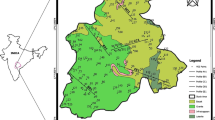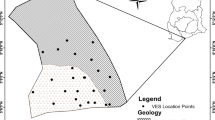Abstract
The study is conducted to focus on the subsurface geological and hydrological mapping for groundwater presence in the area located Nooriabad of the Jamshoro district left side of M-9 Motorway toward Karachi, Sindh, Pakistan. Vertical electrical sounding (VES) is carried out by using the Schlumberger electrode array method with ranging from 02 to 300 m. IPI2win software is used on the collected data of VES to interpret with qualitatively that indicated the four distinct lithological units demarcated as clay, sandy clay, shale and alluvium or weathered layer of Tiyon formation and limestone and fractured sandstone beds of the Laki formation of Eocene age. On the collected VES data, it is concluded that the first and second layer of soil is 16 m thick and composed of shale to clay beds and alluvium having the apparent resistivity between 05 and 15 Ωm. With increasing depth from 50 to 100 m, it is interpreted that there are fractured sandstone and limestone beds with average resistivity ranges between 15 to 60 Ωm. Further, processed the data and generated pseudo-section, apparent resistivity section and statistical curve by using software IPI2win to interpret the apparent resistivity map at 50, 60, 70 and 80 m are correlated with the hydrogeology and geology of the area. The results are interpreted that the good aquifer zones are present in the 50–100-m-thick limestone and fractured sandstone beds having interconnection with clay. Accumulation of groundwater is found by controlling the physiography and geological structure of the study area.

Source: Khan (2012), Geological Survey of Pakistan











Similar content being viewed by others
References
ABEM SAS4000 Terrameter Manual (2010). Page 89
Abdullah S (2010) IWRM and groundwater management. Workshop on “Role of Groundwater in the Management of Water Resources and Governance Issues in Groundwater (Inclusive of Legislation and Institutional Management)”. Ministry of Natural Resources and Environment
Al-Fares W (2016) Using vertical electrical soundings for characterizing hydrogeological and tectonic settings in Deir El-Adas Area, Yarmouk Basin, Syria. Acta Geophys 64(3):610–632. https://doi.org/10.1515/acgeo-2016-0025
Amini A, Ramazi H (2011) Application of electrical resistivity imaging for engineering site investigation. A case study on prospective hospital site, Varamin, Iran. Acta Geophys 64(4):2200–2213. https://doi.org/10.1515/acgeo-2016-0100
Asfahani J (2011) Electrical resistivity investigations for guiding and controlling fresh water well drilling in semi-arid region in Khanasser Valley, Northern Syria. Acta Geophys 59(1):139–154. https://doi.org/10.2478/s11600-010-0031-8
Asfahani J (2012) Quaternary aquifer transmissivity derived from vertical electrical sounding measurements in the semi-arid Khanasser Valley Region, Syria. Acta Geophys 60(4):114–1158. https://doi.org/10.2478/s11600-012-0016-x
Asfahani J, Zakhem BA (2013) Geoelectrical and hydrochemical investigations for characterizing the salt water intrusion in the Khanasser Valley, Northern Syria. Acta Geophys 61(2):422–444. https://doi.org/10.2478/s11600-012-0071-3
Brohi IA, Bablani SA, Solangi SH (2009) Geology and Economic Significance of Tertiary Rocks, Khorwari Section, Surjan Anticline, Thano Bula Khan, Sindh. Sindh Univ Res J 41(1):95–106
Carbajal M. R. (2014). Time-lapse and probabilistic inversion strategies for plane-wave electromagnetic methods. PhD Thesis, p 28
Choudhry K, Saha DK, Chakrabortty P (2001) Geophysical study for saline water intrusion in a coastal alluvial terrain. J Appl Geophys 46:189–200
El-Waheidi MM, Merlanti F, Pavan M (1992) Geoelectrical resistivity survey of the central part of Azraq Basin (Jordan) for identifying saltwater/freshwater interface. J Appl Geophys 29:125–133
Ewusi A, Kuma JS, Voigt HJ (2009) Utility of the 2-D multi-electrode resistivity imaging technique in groundwater exploration in the Voltaian Sedimentary Basin, Northern Ghana. Nat. Resour 18:267–275. https://doi.org/10.1007/s11053-9102-4
Fetter CW (1980) Applied hydrogeology. Merrill Publication, Columbus, p 488
Giang NV, Duan NB, Thanh Le N, Hida N (2013) Geophysical Techniques to Aquifer Locating and Monitoring for Industrial Zones in North Hanoi, Vietnam. Acta Geophys 61(6):1573–1597. https://doi.org/10.2478/s11600-013-0147-8
Gondwe BRN, Sara L, Simon S, Luis M, Mario RV, Gonzalo M, Peter BG (2010) Hydrogeology of the south-eastern Yucatan Peninsula: new insights from water level measurements, geochemistry, geophysics and remote sensing. J Hydrol 389(1–2):1–17. https://doi.org/10.1016/j.jhydol.2010.04.044
Kaya GK (2001) Investigation of groundwater contamination using electric an electromagnetic methods at an open waste-disposal site: a case study from Isparta, Turkey. Environ Geol 40:725–731
Kelly EW (1976) Geoelectric sounding for delineating ground water contamination. Ground Water 14:6–11
Khan, I., (2012), Geological Map of Sindh, Pakistan, issued by Dr. Imran Khan, Director General, Geological Survey of Pakistan
Khan GD, Waheedullah, Bhatti AS (2013) Groundwater investigation by using resistivity survey in Peshawar, Pakistan. J Resour Dev Manag 2:9–20
Khurshaid A, Ahmed N (2014) Determination of aquifer geometry through geophysical methods: a case study from Quetta Valley, Pakistan. Acta Geophys 62(1):142–163. https://doi.org/10.2478/s11600-013-0171-8
Laghari AN, Vanham D, Rauch W (2011) The Indus basin in the framework of current and future resources management. Hydrol Earth Syst Sci Dis 8:2263–3388
Muchingami I, Hlatywayo DJ, Chuma C (2012) Electrical resistivity survey for groundwater investigations and shallow subsurface evaluation of the basaltic-greenstone formation of the urban Bulawayo Aquifer. Phys Chem Earth 50(52):44–51. https://doi.org/10.1016/j.pce.2012.08.014
Owen R, Gwavava O (2005) Multi-electrode resistivity survey for groundwater exploration in the Harare Greenstone Belt, Zimbabwe. Hydrogeol J 14:244–252
Palacky GJ (1988) Resistivity characteristics of geologic targets. Electromagn Methods Appl Geophys 1:52–129
Redhaounia B, Bedir M, Gabtni H, Ilondo B, Dhaoui M, Chabaane A, Khomsi S (2016) Hydro-geophysical characterization for groundwater resources potential of fractured limestone reservoirs in Amdoun Monts (North-western Tunisia). J Appl Geophys 128:150–162. https://doi.org/10.1016/j.jappgeo.2016.03.005
Soupios PM, Kouli M, Valliantos AV, Stavroulakis G (2007) Estimation of aquifer hydraulic parameters from surficial geophysical methods: a case study of Keritis Basin in China (Crete-Greece). J Hydrol 338:122–131
Uchegbulam O, Elijah AA (2014) Application of electrical resistivity imaging in investigating groundwater pollution in Sapele Area, Nigeria. J Water Resour Prot 6:1369–1379. https://doi.org/10.4236/jwarp.2014.614126
Young ME, Debruijin RGM, Salim Al-Ismaily A (1998) Exploration of an alluvial aquifer in Oman by time–domain electromagnetic sounding. Hydrogeol J 6:383–393
Zohdy AAR (1969) Application of deep electrical soundings for groundwater exploration in Hawaii. Geophysics 34:584–600
Acknowledgements
Authors are thankful to PCRWR, Tandojam, and Center for Pure and Applied Geology, University of Sindh, Jamshoro, for providing and supporting the technical assistance during the survey. Authors also would like to acknowledge with special thanks Dr. Maya Silver – Professor, University of Utah, Salt Lake City, USA, who paid special time for this manuscript editing and anonymous reviewers of Acta Geophysica for their useful comments and suggestions, which led me enhancing the quality of the paper. First author is highly thankful to USPCAS-W, MUET, Jamshoro, Pakistan, for providing the valued environment to proceed for this PhD research paper.
Author information
Authors and Affiliations
Corresponding author
Rights and permissions
About this article
Cite this article
Soomro, A., Qureshi, A.L., Jamali, M.A. et al. Groundwater investigation through vertical electrical sounding at hilly area from Nooriabad toward Karachi. Acta Geophys. 67, 247–261 (2019). https://doi.org/10.1007/s11600-019-00247-9
Received:
Accepted:
Published:
Issue Date:
DOI: https://doi.org/10.1007/s11600-019-00247-9




